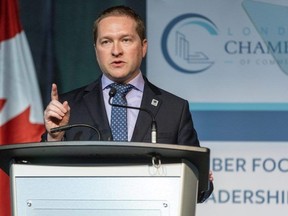With 2023 in the rear-view mirror, its clear London is far from qualifying for its slice of extra provincial funding for meeting housing targets for the year.

With 2023 in the rear-view mirror, its clear London is far from qualifying for its slice of extra provincial funding for meeting housing targets for the year. LFP’s Jack Moulton takes a look at why London could only muster around 50 per cent, and how it could improve going forward.
Advertisement 2
Article content
Article content
HOW DOES THIS WORK?
In an effort to meet its own goal of 1.5 million new homes by 2031, the provincial government rolled out the Building Faster Fund in August.
The fund would dole out $1.2 billion over three years to the largest cities in the province based on whether they met targets for new housing starts. Fifty of the largest municipalities were given targets they had to hit by 2031, broken down year by year.
If a city reaches 80 per cent of its target or more in a year, they can tap into the fund, meant to help offset some of the costs for building housing such as water and sewer connections. If they exceed their targets, they can tap into bonus funds.
A new home can mean anything from single family homes, to apartments and condos, laneway and garden suites, and even long term care beds.
Advertisement 3
Article content
WHERE DOES LONDON STAND?
According to federal and provincial data, as of Feb. 22, London broke ground on 1,804 new homes in 2023. This is just 52 per cent of what the province wanted the city to build last year, 3,447 units. Overall, the province wants London to bring in 47,000 new homes by 2031. Since 2022, London has built 4,313 new homes.
London was among 24 out of 50 cities to not meet their targets.
Recommended from Editorial
SO WHAT HAPPENED?
Mike Wallace is executive director of the London Development Institute, a consortium of local developers. He says the simple answer is high interest rates slowing the appetite for homebuyers and developers.
Advertisement 4
Article content
“It isn’t that demand went away, but people were making the choice not to pull the trigger and go buy new homes, because they were waiting to see what was going to happen with interest rates, and . . . made it much less affordable to start with,” he said.
He also points to how cities that met or exceeded their targets may have had construction predating the program which counted toward this year’s total.
Mayor Josh Morgan says that 7,100 units of multi-residential homes are being built in London right now, some of which may be years away from completion. Council also granted permissions for 5,337 new homes last year, technically exceeding the province’s goal.
“That’s a challenge for us because. . . there’s never been more activity than at this time,” Morgan said. “Yet because of where you know the yardsticks are dropped. . . we have many units that are either already counted in previous years or not yet counted.”
Advertisement 5
Article content
SO HOW CAN LONDON IMPROVE?
Wallace says the main thing London can do to boost its numbers is to speed up building permits. He says it can take between five to 10 years to get permits, and that it should ideally only take two to three.
To that end, the development community and city hall are pledging to work together to improve that process, including hiring more staff in the municipal planning and development department.
“We’re going to talk about the activity that’s happening, we’re going to talk about some of the challenges that they’re facing, and . . . figure out how we can get those permissions turning into units faster,” Morgan said.
HOW DID OTHER LOCAL MUNICIPALITIES DO?
- London: 1,804 of 3,447 new homes, or 52 per cent
- Windsor: 346 of 953 new homes, or 36 per cent
- Chatham-Kent: 522 of 81 new homes, or 644 per cent
- Woodstock: 120 of 403 new homes, or 30 per cent
- Sarnia: 254 of 73 new homes, or 348 per cent
- Norfolk County: 269 of 418 new homes, or 64 per cent
Article content

